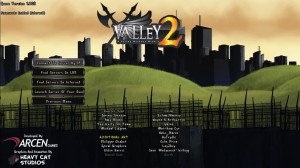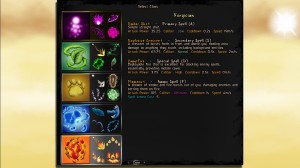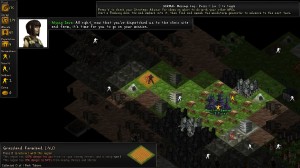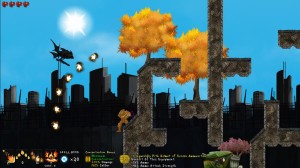I wasn’t sure what to expect from “A Valley Without Wind 2” (hereby dubbed “AVWW2”), having never played the first one. All I knew is that it was a sequel designed to improve upon the original, the latter of which was received with mixed results. In “AVWW2”, you’ll take on the role of a mage who’s managed to infiltrate the ranks of the evil Demonaica. You’ve just acquired a power that rivals that of Demonaica, and your goal will be to break your cover and lead the resistance to victory. The game itself is a mix of genres, concentrating heavily on side-scrolling and empire management. Before we begin taking a look at this game in further detail, I’d like to thank Erik Johnson from Arcen Games for providing me with a free review copy.
The main menu is similar to that of “Shattered Haven”, a game recently developed by Arcen Games. I will say right off the bat that I enjoyed the menu music: the male and female duet was particularly uplifting. “Settlers 7” did something similar and the music stuck with me, just as this composition is bound to do. You’ll be allowed to play in single or multiplayer games, adjust game options…The options menu covers your basics, touching on-screen resolution, fullscreen toggle, control schemes & keybinding, audio sliders, and some advanced graphical options like vsync.
Starting a new game allows you to create and name a world, choose from a list of randomly generated characters that have varying attributes, name that character, and pick one of five spell classes. There’s a wide range of difficulties to choose from as well and I highly recommend that you pick the easier ones on your first few playthrus, just until you get used to how the game mechanics work. You can continue to randomly generate avatars during character creation so as to get the stats and look you want, though I wouldn’t have minded a system that just allowed me to manually customize them. The baseline stats are hearts, ammo, and attack…the more you have of each, the better. Each of the spell classes comes with four spells that revolve around a particular element like fire, water, nature, and etc.
The game starts you in front of Demonaica, just before you reveal your cover and attempt to aid the resistance. It’s here that the game will take you through a tutorial of sorts, allowing you to get used to the controls in relation to the side-scrolling parts of the game. Like “Shattered Haven”, you’ll be using the “ASDF” keys to perform actions, in this case, casting the four spells that you’ve been given. I rebound the jump key from the space bar to the up arrow, namely because I found it to be awkward. Other than that, the control scheme was fine as-is. The interface during the side-scrolling portions is fairly easy to read, though I admit I still don’t know what everything does…more on that later.
After completing the tutorial, you’ll be thrust into a world map (overworld) view. I admit to being a bit overwhelmed at first by all of the information it was displaying, but to sum things up, the world is divided into grids. Some grids are revealed and some are shrouded by the fog of war. You can move your character freely across most tiles, save for impassable ones and those you can’t see yet. Time doesn’t pass while this occurs either, giving you time to explore the world map a bit and play around with the various panels and menus. You’ll also note that you’ve been given resistance fighters to move around and it’s vital that you keep them alive if possible. Losing all of them drops your population to zero, effectively ending the game.
There’s a bit of empire management going on in the overworld view. On the left hand side of the screen you’ll see things like food, morale, population, and etc. that gives you an idea as to how well you’re doing. You can order your forces to construct buildings and improvements at various locations to assist in their survival. Farms and clinics, for example, are two of the buildings you’ll need straight away to ensure their health and morale. A handy strategic advisor is available to assist you in learning the ropes, as well as to guide you in what you should be doing next. I’m not going to lie, there is a LOT of information here, but I’m grateful that there are resources available to help me understand what is going on.
Once you’re done moving troops around in the overworld view, you’ll pick a grid with your character and enter the region. The game switches gears at this point over to the side-scrolling view, where you’ll need to progress from one end of the level to the other without dying. You’ll primarily be using the spells you’ve been given to dispatch enemies, and you’ll need to do that as they drop health and ammo to help replenish your character. Loot can be found in chests on occasion, though the game only allows you to carry one piece at a time. Loot can buff or debuff various things like character speed, attack power, resistance to damage, and etc. It’s important to check a chest before looting it, as the change in ownership is permanent. This stage of the game is very shooter-esque and if I may say so, “odd.” The enemy NPCs you’ll face are varied indeed, featuring land sharks, blobs of water, flying machines, and other weird-looking contraptions that will haunt your dreams for weeks on end.
There’s too much to get into for the sake of a review, but to sum up gameplay, you’ll be leveling up your character, seeing to the well-being of your forces, capturing grids, constructing buildings, and engaging in side-scrolling action, all with the goal of taking out Demonaica once and for all. You’ll be switching back and forth between overworld and side-scrolling views, which in most cases complete turns and causes the world around you to progress. Enemies get more powerful as the game goes on, so you’ll need to find ways to level your character up in order to stay competitive. Cooperative multiplayer is available, and the game features a clear beginning, middle, and endgame phase unlike its predecessor. The game promises, “50 mage classes in 5 tiers, 200 spells, 125 enemies, 14 biomes, 100+ types of world map tiles, 64 character customization perks, 100ks of procedural equipment possibilities” (source), so there’s plenty of content there to keep the player busy for a while.
In the end, “A Valley Without Wind 2” is an enjoyable experience that features a ton of depth. I really enjoyed managing forces on the overworld map and improving my character, though I found the platforming to be a bit clunky and repetitive. There is a bit of a learning curve, so those of you seeking instant gratification will be disappointed. Even though the game has a strategic advisor, you WILL scratch your head at times as you attempt to put the pieces together. This is a game you’ll need to stick with for a while to fully understand its ins and outs. It rewards those willing to explore its features and offers almost unlimited replayability, seeing as how worlds randomly generate from the get go. The difficulty levels are varied, allowing both casual and expert players to stay challenged throughout their experience. It’s worth a look, especially if you enjoy games that revolve around empire management.
Final Verdict: 8/10
Editor’s Note: It’s worth mentioning that owners of “AVWW1” received “AVWW2” for free and vice versa. I think that’s a great move on the developer’s part and goes a long way in stating their intentions with their consumer base. I look forward to trying out “AVWW1” if I have the time, mainly to see what inspired the development of “AVWW2”.
—
You can learn more and purchase “A Valley Without Wind 2” by visiting the following websites:
http://www.arcengames.com/w/index.php/games/avww-features
http://store.steampowered.com/app/228320/?snr=1_7_15__13
You can check out the Wiki here:
http://www.arcengames.com/mediawiki/index.php?title=A_Valley_Without_Wind
Editor’s Note: While this Wiki is for the first game of the series, some of the gameplay mechanics carried over to the sequel making it a viable primer.
You can view gameplay videos here:
http://www.youtube.com/watch?v=M7L8mss3SYc
You can listen to the menu music here:
—




